The genesis of a masterpiece: Unterschied zwischen den Versionen
Keine Bearbeitungszusammenfassung |
Keine Bearbeitungszusammenfassung |
||
| (10 dazwischenliegende Versionen desselben Benutzers werden nicht angezeigt) | |||
| Zeile 1: | Zeile 1: | ||
A. Lange & Söhne delivers the first GRAND COMPLICATION | A. Lange & Söhne delivers the first GRAND COMPLICATION | ||
[[Datei:A Lange Söhne Ref 912 032 FS a4.jpg|thumb|The [[Complication/en|GRAND COMPLICATION]] is the most complicated wristwatch ever built in Germany.]] | [[Datei:A Lange Söhne Ref 912 032 FS a4.jpg|thumb|The [[Complication/en|GRAND COMPLICATION]] is the most [[Complication/en|complicated]] [[wristwatch]] ever built in Germany.]] | ||
Glashütte, June 2016 | Glashütte, June 2016 | ||
In January [[2013/en|2013]], [[Lange Uhren GmbH|A. Lange & Söhne]] presented the most complicated wristwatch ever built in Germany. Only six of these oeuvres will ever be crafted, and the first one has now been handed over to its owner. The assembly of the movement alone requires an entire year for each watch. Meanwhile, some of the countless steps involved in the making of this micromechanical masterpiece have been photographically documented. | In January [[2013/en|2013]], [[Lange Uhren GmbH|A. Lange & Söhne]] presented the most [[Complication/en|complicated]] [[wristwatch]] ever built in Germany. Only six of these oeuvres will ever be crafted, and the first one has now been handed over to its owner. The assembly of the movement alone requires an entire year for each watch. Meanwhile, some of the countless steps involved in the making of this micromechanical masterpiece have been photographically documented. | ||
The GRAND COMPLICATION is a homage to the grand tradition of Saxon precision watchmaking and also marks the dawn of a new era in the history of A. Lange & Söhne. According to Lange’s Product Development Director Anthony de Haas, the development of this complication and its fascinating chiming mechanism “unleashed creative momentum among our product designers and opened up a wide passageway for new solutions.” | The GRAND COMPLICATION is a homage to the grand tradition of Saxon precision watchmaking and also marks the dawn of a new era in the history of [[A. Lange & Söhne / Glashütte i. Sa./en|A. Lange & Söhne]]. According to Lange’s Product Development Director Anthony de Haas, the development of this complication and its fascinating chiming mechanism “unleashed creative momentum among our product designers and opened up a wide passageway for new solutions.” | ||
The GRAND COMPLICATION incorporates a grand and small strike, a minute repeater, a split-seconds chronograph with a minute counter and flying seconds, as well as a perpetual calendar with a moon-phase display. Only the most talented and experienced watchmakers have the skills needed to master the challenges associated with the assembly and intricate adjustment of the 876-part movement. And even they need a whole year to get the job done. The task requires in-depth expertise, concentration, dexterity, and – above all – patience. | The GRAND COMPLICATION incorporates a grand and small strike, a minute [[repeater]], a [[Double Chronograph/en|split-seconds chronograph]] with a minute counter and [[Blitzende Sekunde|flying seconds]], as well as a [[perpetual calendar]] with a [[moon-phase display]]. Only the most talented and experienced watchmakers have the skills needed to master the challenges associated with the assembly and intricate adjustment of the 876-part [[movement]]. And even they need a whole year to get the job done. The task requires in-depth expertise, concentration, dexterity, and – above all – patience. | ||
This is because the assembly process also includes exhaustive tests, especially to ensure correct functioning of the chiming mechanism. For this purpose, the strikes are recorded in 24-hour cycles over a period of several weeks. The subsequent evaluation of the recordings is performed to confirm that the mechanism properly sounds all quarter hours. If this is not the case, it must be completely disassembled, readjusted, reassembled and tested again. “Free without play”: This is the – actually physically impossible – instruction passed on to the watchmaker as a description of the ideal interaction of the moving parts of a chiming mechanism. | This is because the assembly process also includes exhaustive tests, especially to ensure correct functioning of the chiming mechanism. For this purpose, the strikes are recorded in 24-hour cycles over a period of several weeks. The subsequent evaluation of the recordings is performed to confirm that the mechanism properly sounds all quarter hours. If this is not the case, it must be completely disassembled, readjusted, reassembled and tested again. “Free without play”: This is the – actually physically impossible – instruction passed on to the watchmaker as a description of the ideal interaction of the moving parts of a chiming mechanism. | ||
Aktuelle Version vom 10. Juni 2016, 23:28 Uhr
A. Lange & Söhne delivers the first GRAND COMPLICATION
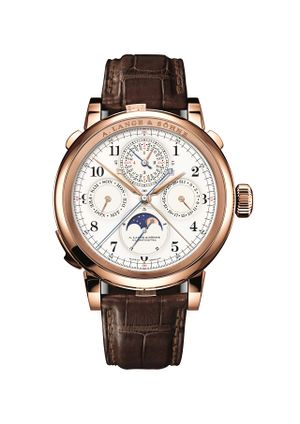
Glashütte, June 2016
In January 2013, A. Lange & Söhne presented the most complicated wristwatch ever built in Germany. Only six of these oeuvres will ever be crafted, and the first one has now been handed over to its owner. The assembly of the movement alone requires an entire year for each watch. Meanwhile, some of the countless steps involved in the making of this micromechanical masterpiece have been photographically documented.
The GRAND COMPLICATION is a homage to the grand tradition of Saxon precision watchmaking and also marks the dawn of a new era in the history of A. Lange & Söhne. According to Lange’s Product Development Director Anthony de Haas, the development of this complication and its fascinating chiming mechanism “unleashed creative momentum among our product designers and opened up a wide passageway for new solutions.”
The GRAND COMPLICATION incorporates a grand and small strike, a minute repeater, a split-seconds chronograph with a minute counter and flying seconds, as well as a perpetual calendar with a moon-phase display. Only the most talented and experienced watchmakers have the skills needed to master the challenges associated with the assembly and intricate adjustment of the 876-part movement. And even they need a whole year to get the job done. The task requires in-depth expertise, concentration, dexterity, and – above all – patience.
This is because the assembly process also includes exhaustive tests, especially to ensure correct functioning of the chiming mechanism. For this purpose, the strikes are recorded in 24-hour cycles over a period of several weeks. The subsequent evaluation of the recordings is performed to confirm that the mechanism properly sounds all quarter hours. If this is not the case, it must be completely disassembled, readjusted, reassembled and tested again. “Free without play”: This is the – actually physically impossible – instruction passed on to the watchmaker as a description of the ideal interaction of the moving parts of a chiming mechanism.
Some of the most important of the thousands of steps needed on the way to the genesis of a horological masterpiece:
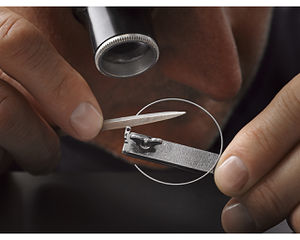
Filing the gongs
The quality of the gongs determines the sonority of the chiming mechanism. The alloy, the hardness, the shape, the attachment – the engineers and technologists have found the optimal solution for every detail, no matter how insignificant it may seem. Here, the foot of the gong is fashioned into a triangular shape with a diamond file so it can vibrate better when struck.
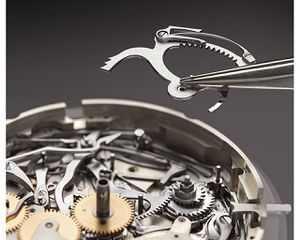
Assembly of the racks
The three racks of the chiming mechanism are key elements that control the hour, quarter-hour and minute strikes. The quarter rack shown here triggers one to three double strikes for 15, 30 and 45 minutes after the top of the hour. It is made of hardened steel and decorated with straight graining on the upper side.

Assembly of the gathering pallets
The gathering pallets are deflected by the teeth of the racks. Via arbors, they are connected to the hammers which strike the gongs and generate the sounds. The gathering pallets are made of hardened steel and must be painstakingly fine-tuned by hand to ensure pure sonority.
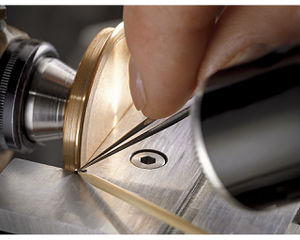
Grinding the chiming mechanism lever
The chiming mechanism is powered by a separate spring barrel and features its own wheel train with a lever escapement that ensures the uniform operation of the mechanism. The shape of this lever is so complex that after it has been mechanically produced, it has to be manually adjusted with a brass disc and abrasive paste.
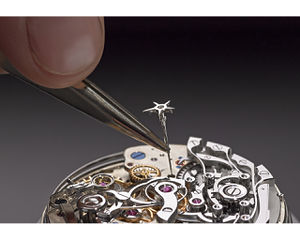
Assembly of the flying seconds mechanism
The flying seconds hand displays stopped times to an accuracy of one-fifth of a second. When the chronograph is started, two superposed five-point stars that share the same arbor will begin to rotate about their axis once per second. During the process, a 30-tooth brass wheel – shown here beneath the tweezers – stops and releases them five times per second.

Alignment of the rattrapante arbor
The rattrapante arbor is about 17.4 millimetres long. It has a diameter of just 0.292 millimetres and extends from the dial to the rattrapante wheel on the underside of the movement. Because stresses occur in the material when the arbor is turned, it must be aligned on a specially made brass block before it is installed.

Grinding the gold lever
The “Glashütte lever escapement” pays tribute to Lange’s legacy: Its lever and escape wheel are made of hardened 18-carat gold. Considerable manual work is involved because many parts cannot be produced with machines. Here, an arm of the gold lever – in which the synthetic ruby pallet is mounted – is rounded on the inside of a rotating copper tube.

Setting the bearing jewels
Usually, bearing jewels are simply pressed into their bores. In the GRAND COMPLICATION, all bearing jewels are provided with their own settings on the movement side, as was traditionally the case in the finest pocket watches. Here, the setting of an endstone in the rattrapante cock is closed on a lathe.

Slotting the balance rim
With a milling cutter designed by Lange especially for this purpose, tiny slots are cut into the balance wheel rim right next to the bores. Later, they will expand around the threaded bores and ensure that the poising screws are firmly seated. The screws are inserted in the rim at various depths as needed to poise the balance. There, they must retain their positions and not work themselves loose. To prevent the cutter from overheating, it is cooled with a brush dipped in ethyl alcohol.